Day 3, the final day of a long weekend of Spring Tours today. The focus was on the area around Wells and Holkham. It was a lovely sunny morning, a little cloudier in the afternoon, but there was quite a strong westerly breeze again all day which kept it cool.
We started with a visit to a local gull colony. The vast majority of nests were Black-headed Gulls, and very noisy they were too. But in amongst them, we could pick out a few pairs of Mediterranean Gulls, their jet black hoods standing out against the (ironically) chocolate brown hoods of the Black-headed Gulls.
 Mediterranean Gull – a smart adult collecting nest material
Mediterranean Gull – a smart adult collecting nest material
We spent some time watching the Mediterranean Gulls collecting nest material – several adults with pure white wing tips, but also several 2nd summer birds with a small amount of black in the wings still. One of the 2nd summers had a full black hood, but the other still had lots of white around the face. Still, both of them appeared to be paired up.
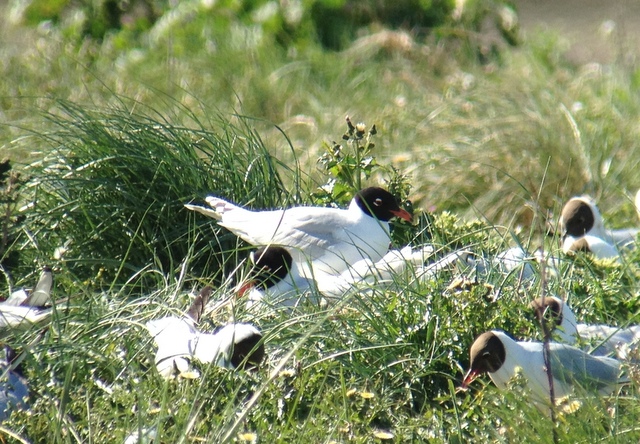 Mediterranean Gull – a 2nd summer bird with black markings in the wing tip
Mediterranean Gull – a 2nd summer bird with black markings in the wing tip
There were other gulls to look at here as well. Common Gulls are not the commonest gulls in this part of the world (gull names are really confusing!), though we do get more in the winter, but a few pairs nest here too. They were looking really smart today, with their pure white heads, dark eyes and yellow bills. Very dainty compared to the more menacing Herring Gulls which were hanging round the edge of the colony as well.
As well as the gulls, there are a few terns nesting here. The most obvious are the Common Terns, and several were flying round and calling loudly. When they landed, we got a good look at them through the scope, their longish, bright red bills tipped with black. After looking for a while, we eventually saw a pair of Arctic Terns fly in and land on the beach. We could see their shorter, darker, blood-red bills, lacking a black tip, and their long tails projecting clearly beyond the wing tips. Smart birds. We are at the southern edge of the breeding range for Arctic Terns here, so it is always nice to see them. We could also see (and hear) some Little Terns feeding in the channel and a little group flew in and landed on the beach so we could get a good look at them too.
Through the winter, there is normally a good selection of waders here, but most of them have now departed. There were plenty of Oystercatchers out on the mud and a single Ringed Plover, but that was it. However, as we were packing up to leave, a couple of Bar-tailed Godwits flew past. A nice bonus.
Our next stop was Burnham Overy. We walked out along the track across the grazing marshes towards the seawall. There were several Whitethroats singing on the way out, and a single Lesser Whitethroat doing the same but from deep within a thick bank of hawthorn. It was showing no inclination to come out in the windy conditions. The Sedge Warblers, as usual, were a little more obliging, though even they were keeping lower down in the bushes today.
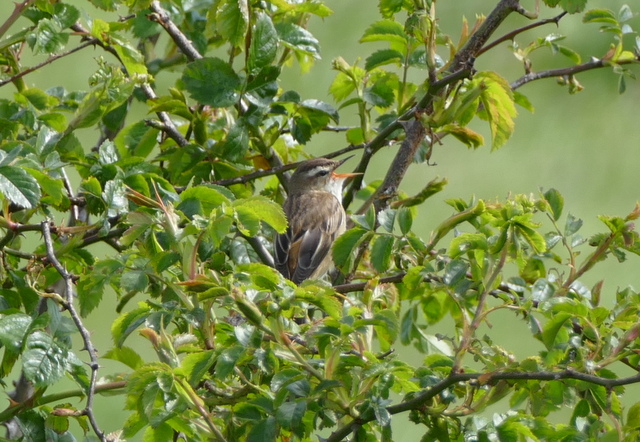 Sedge Warbler – singing from the shelter of a wild rose
Sedge Warbler – singing from the shelter of a wild rose
We could also hear a male Cuckoo singing. It was some way off at first, towards Burnham Overy Staithe, but as we walked it seemed to be coming a little closer. Finally we saw it fly out from the trees and disappear behind a hedge, looking rather like a cross between a hawk and a falcon as it flew.
There were quite a few geese out on the grazing marshes, though none of the really big flocks which spend the winter here. Most of them were feral Greylags, but with several Egyptian Geese as well. Scanning through them, we picked up a smaller grey goose, with a dark head – a properly wild Pink-footed Goose. We got it in the scope and admired its pink bill-band, legs and feet. Most of the Pink-footed Geese left in February, but a small number of mostly sick or injured birds remain here right through the summer.
As we were walking out, a single Spoonbill flew over from the direction of Holkham and disappeared over the seawall in the direction of Burnham Overy harbour. We climbed up onto the seawall and could see it very distantly, feeding out towards Gun Hill. There were not so many waders out on the saltmarsh here today either – mostly a few Oystercatcher and Redshank, but there were a handful of Grey Plover now in very smart summer plumage with jet black bellies and faces. Stunning! A single Whimbrel flew up from the saltmarsh, calling, and we later found it feeding out on the grazing marshes near the dunes. They have been surprisingly scarce so far this spring.
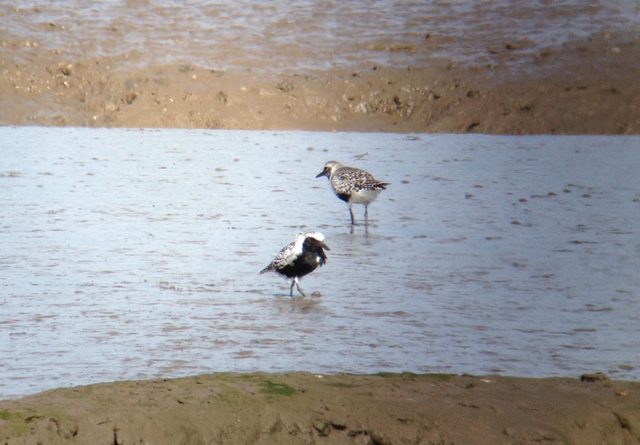 Grey Plovers – looking stunning in summer plumage
Grey Plovers – looking stunning in summer plumage
There were several Swifts flying close around us up on the seawall, enjoying the wind. There were lots up in the sky over the grazing marsh as well. In fact, all day there seemed to be Swifts overhead, gradually making their way west. There was also a steady trickle of hirundines on the move – Swallows, House Martins and Sand Martins. This migration was most obvious out in the dunes, little groups of Swallows especially flying past us every few minutes. It is always nice to see visible migration in action. However, there was few other signs of it today. As we got out to the boardwalk, a single Yellow Wagtail flew over calling.
The dunes were also rather quiet, apart from the ubiquitous Linnets and Meadow Pipits here. There were not many butterflies today either, just several Cinnabar Moths keeping low in the dunes and still being battered by the wind.
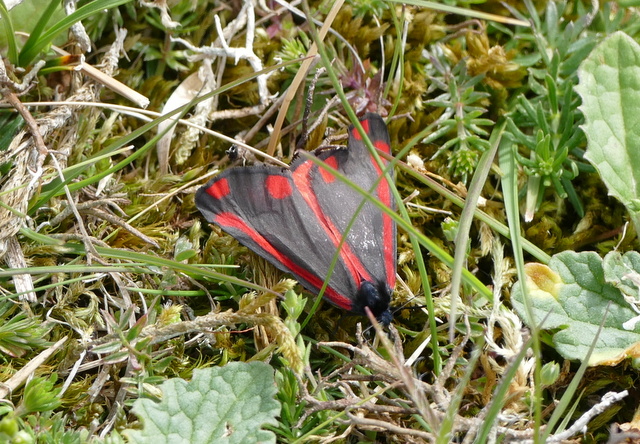 Cinnabar Moth – keeping low out of the wind in the dunes
Cinnabar Moth – keeping low out of the wind in the dunes
It was only when we got to the far side of Gun Hill that we found our first Wheatear. It was sheltering behind a concrete block, trying to get out of the wind. The Greenland Wheatears in the dunes have been very obliging recently, but this one was very jumpy today in the blustery conditions and flew off as we approached.
There was no sign of the Spoonbill in the harbour initially – we presumed it must have flown off as we walked out. But as we stood on the beach we saw a head appear behind the ridge of mud in front of us. The Spoonbill was still there, feeding quietly on the edge of the channel, and we watched it walk past, mostly with its head down and sweeping its bill from side to side through the shallow water.
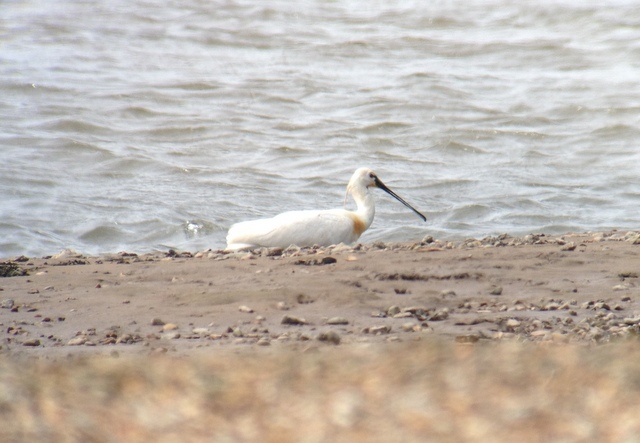 Spoonbill – this smart adult was feeding in the channel at Overy harbour
Spoonbill – this smart adult was feeding in the channel at Overy harbour
As we walked back to Gun Hill, we flushed the Wheatear again from the edge of the dunes and realised there was a second bird there now, another female. Unfortunately, they were both equally jumpy. We walked back to the boardwalk and a little beyond, to a nice sheltered bowl in the dunes where we thought there might be some birds. There were two more Wheatears as well here, but no sign of any other migrants today.
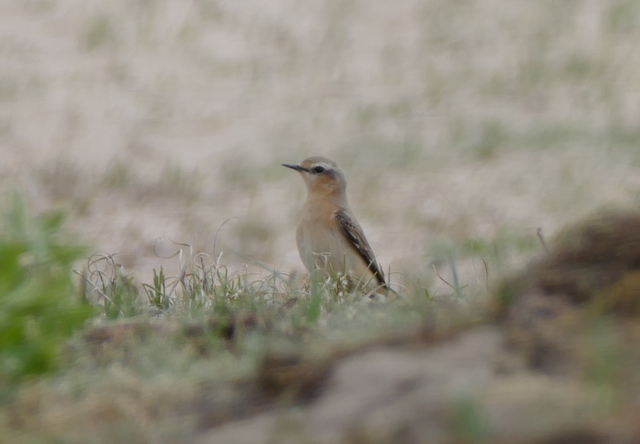 Wheatear – the females in the dunes were very jumpy today
Wheatear – the females in the dunes were very jumpy today
While we were standing there in the dunes, we could hear the sound of a Bittern booming. It was obviously carried on the wind, as we were a long way from the reeds here. We decided to walk back along the seawall and get a bit closer. We sat down on the bank by the reedbed and waited, and before long we could hear the Bittern again. We heard it several times, but there was no fly round today while we were there. We did see a few Bearded Tits zooming back and forth over the reeds, which was a nice bonus. And another Spoonbill feeding on the reedbed pool.
It was time to head back for lunch. We heard the male Cuckoo singing again, and saw him fly off distantly across the grazing marsh. Then, as we walked back, we heard the distinctive bubbling call of a female Cuckoo from the hedgerows. The local Meadow Pipits and Dunnocks had better watch out!
After lunch at Lady Anne’s Drive, we walked out west by Holkham Pines. It was still rather windy, even on the edge of the pines today, and there were fewer warblers singing than usual. A single Little Grebe was on Salts Hole.
From Joe Jordan hide, a couple of Spoonbills were on show as we arrived, preening down by the pool. As we sat in the hide and watched, we saw more fly in and out of the colony. There are always other things to see here as well. There were lots of Marsh Harriers flying around the trees, despite the wind. At one point, a smart male came in low over the grass in front of the hide, carrying some prey. He circled over the reeds and a female flew up, at which point he passed the food to her and flew off. A closer look at photos later suggested that he may have eaten half the meal before he brought it back for her!
 Marsh Harrier – this male brought back food for the female
Marsh Harrier – this male brought back food for the female
We also watched a pair of Grey Partridge feeding quietly in the grass below the hide. Another Yellow Wagtail flew past us calling.
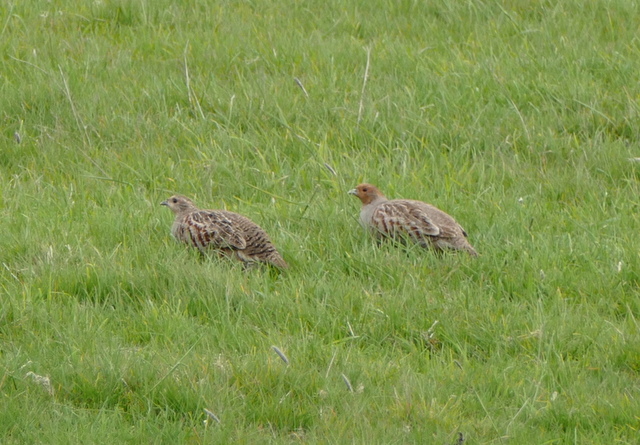 Grey Partridge – this pair were feeding below the Joe Jordan hide
Grey Partridge – this pair were feeding below the Joe Jordan hide
We carried on west and had a quick look in the dunes at the end of the pines. A single Lesser Whitethroat was the only bird of note. We were just leaving when a Hobby flashed past us. Watching it fly low into the dunes, a Red Kite appeared just above it, hanging on the breeze. An unlikely combination, we had both of them in the same view together, before the Hobby disappeared and the Red Kite drifted right past us, pursued by a Carrion Crow.
 Red Kite – hunting over the dunes this afternoon
Red Kite – hunting over the dunes this afternoon
There was a bit more activity on the edge of the pines on our way back. There were a few more Willow Warblers and Chiffchaffs singing, we heard several Goldcrests and a couple of Treecreepers, and saw a variety of tits. Back at Salts Hole, we heard a Kingfisher calling and found it perched low in an oak tree. We just had time to all get a look at it through the scope before it darted off across the water. They are really lovely birds.
A short detour inland on the way back saw us stop in some farmland where another pair of Turtle Doves perched up for us. They are very scarce birds in Norfolk these days, so we did really well to see as many as we did over the long weekend. Then it was time to head back.
















